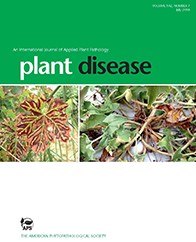Ver ítem
- xmlui.general.dspace_homeCentros e Institutos de InvestigaciónCIAP. Centro de Investigaciones AgropecuariasInstituto de Patología VegetalArtículos científicosxmlui.ArtifactBrowser.ItemViewer.trail
- Inicio
- Centros e Institutos de Investigación
- CIAP. Centro de Investigaciones Agropecuarias
- Instituto de Patología Vegetal
- Artículos científicos
- Ver ítem
First Report of Cladode Brown Spot in Cactus Prickly Pear Caused by Neofusicoccum batangarum in Brazil
Resumen
Cactus prickly pear (Nopalea cochenilifera) cladodes showing brown spot symptoms were collected of 18 fields of the State of Pernambuco, northeastern Brazil, from March to June 2014. The symptoms were prevalent in 100% of fields surveyed. Small pieces (4 to 5 mm) of necrotic tissues were surface sterilized for 1 min in 1.5% NaOCl, washed twice with sterile distilled water, and plated onto potato dextrose agar (PDA) amended with 0.5 g /liter streptomycin
[ver mas...]
Cactus prickly pear (Nopalea cochenilifera) cladodes showing brown spot symptoms were collected of 18 fields of the State of Pernambuco, northeastern Brazil, from March to June 2014. The symptoms were prevalent in 100% of fields surveyed. Small pieces (4 to 5 mm) of necrotic tissues were surface sterilized for 1 min in 1.5% NaOCl, washed twice with sterile distilled water, and plated onto potato dextrose agar (PDA) amended with 0.5 g /liter streptomycin sulfate. Colonies morphologically similar to species of Botryosphaeriaceae were transferred to malt extract agar (MEA); five isolates (CMM 1424, CMM 1425, CMM 1426, CMM 1427, and CMM 1428) presented colonies forming concentric rings, and white mycelium becoming gray to gray-olivaceous after 5 days. Conidial characters were observed after growth on 2% water agar bearing sterilized pine needles for 3 weeks at 25°C under near-UV light. Conidiogenous cells holoblastic, hyaline, smooth, and cylindrical. Conidia were nonseptate, hyaline, smooth, fusoid to ovoid, thin-walled, 15.3 ± 1.4 × 5.4 ± 0.6 µm (n = 50), L/W ratio= 2.8, which are morphological and cultural characteristics typical of Neofusicoccum spp. (Phillips et al. 2013). DNA sequencing of part of the elongation factor 1-alpha (EF1-α) gene and the internal transcribed spacer (ITS1-5.8S-ITS2 rDNA) region were conducted to identify the species as described by (Marques et al. 2013). Sequences of the isolates were 99% similar to those of N. batangarum for EF1-α (GenBank Accession Nos. FJ900653 and FJ900654) and ITS (FJ900607 and FJ900608).
[Cerrar]

Autor
Conforto, Erica Cinthia;
Bernanrdi Lima, Nelson;
Garcete-Gómez, J. M.;
Câmara, M. P. S.;
Michereff, S. J.;
Fuente
Plant Disease 100 (6) : 1238 (June 2016)
Fecha
2016-03-18
Editorial
American Phytopathological Society
ISSN
0191-2917
1943-7692 (online)
1943-7692 (online)
Formato
pdf
Tipo de documento
artículo
Palabras Claves
Derechos de acceso
Abierto
 Excepto donde se diga explicitamente, este item se publica bajo la siguiente descripción: Creative Commons Attribution-NonCommercial-ShareAlike 2.5 Unported (CC BY-NC-SA 2.5)
Excepto donde se diga explicitamente, este item se publica bajo la siguiente descripción: Creative Commons Attribution-NonCommercial-ShareAlike 2.5 Unported (CC BY-NC-SA 2.5)


